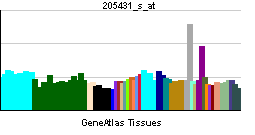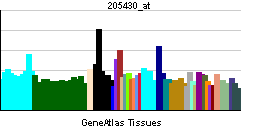BMP5 (gene)
| Bone morphogenetic protein 5 | |||||||||||
|---|---|---|---|---|---|---|---|---|---|---|---|
| Identifiers | |||||||||||
| Symbols | BMP5 ; MGC34244 | ||||||||||
| External IDs | Template:OMIM5 Template:MGI HomoloGene: 22412 | ||||||||||
| |||||||||||
| RNA expression pattern | |||||||||||
 | |||||||||||
 | |||||||||||
| More reference expression data | |||||||||||
| Orthologs | |||||||||||
| Template:GNF Ortholog box | |||||||||||
| Species | Human | Mouse | |||||||||
| Entrez | n/a | n/a | |||||||||
| Ensembl | n/a | n/a | |||||||||
| UniProt | n/a | n/a | |||||||||
| RefSeq (mRNA) | n/a | n/a | |||||||||
| RefSeq (protein) | n/a | n/a | |||||||||
| Location (UCSC) | n/a | n/a | |||||||||
| PubMed search | n/a | n/a | |||||||||
Bone morphogenetic protein 5, also known as BMP5, is a human gene.[1]
This gene encodes a member of the bone morphogenetic protein family which is part of the transforming growth factor-beta superfamily. The superfamily includes large families of growth and differentiation factors. Bone morphogenetic proteins were originally identified by an ability of demineralized bone extract to induce endochondral osteogenesis in vivo in an extraskeletal site. These proteins are synthesized as prepropeptides, cleaved, and then processed into dimeric proteins. This protein may act as an important signaling molecule within the trabecular meshwork and optic nerve head, and may play a potential role in glaucoma pathogenesis. This gene is differentially regulated during the formation of various tumors.[1]
References
Further reading
- Hahn GV, Cohen RB, Wozney JM; et al. (1992). "A bone morphogenetic protein subfamily: chromosomal localization of human genes for BMP5, BMP6, and BMP7". Genomics. 14 (3): 759–62. PMID 1427904.
- Celeste AJ, Iannazzi JA, Taylor RC; et al. (1991). "Identification of transforming growth factor beta family members present in bone-inductive protein purified from bovine bone". Proc. Natl. Acad. Sci. U.S.A. 87 (24): 9843–7. PMID 2263636.
- Sakaue M, Kitazawa S, Nishida K; et al. (1996). "Molecular cloning and characterization of human bone morphogenic protein (BMP)-5 gene promoter". Biochem. Biophys. Res. Commun. 221 (3): 768–72. doi:10.1006/bbrc.1996.0671. PMID 8630036.
- You L, Kruse FE, Pohl J, Völcker HE (1999). "Bone morphogenetic proteins and growth and differentiation factors in the human cornea". Invest. Ophthalmol. Vis. Sci. 40 (2): 296–311. PMID 9950587.
- Imai N, Iwai A, Hatakeyama S; et al. (2001). "Expression of bone morphogenetic proteins in colon carcinoma with heterotopic ossification". Pathol. Int. 51 (8): 643–8. PMID 11564221.
- Beck HN, Drahushuk K, Jacoby DB; et al. (2003). "Bone morphogenetic protein-5 (BMP-5) promotes dendritic growth in cultured sympathetic neurons". BMC neuroscience. 2: 12. PMID 11580864.
- Jin Y, Lu HB, Liong E; et al. (2002). "Transcriptional mRNA of BMP-2, 3, 4 and 5 in trigeminal nerve, benign and malignant peripheral nerve sheath tumors". Histol. Histopathol. 16 (4): 1013–9. PMID 11642720.
- Cohen A, Mulas R, Seri M; et al. (2002). "Meier-Gorlin syndrome (ear-patella-short stature syndrome) in an Italian patient: clinical evaluation and analysis of possible candidate genes". Am. J. Med. Genet. 107 (1): 48–51. PMID 11807867.
- Jiang FX, Stanley EG, Gonez LJ, Harrison LC (2002). "Bone morphogenetic proteins promote development of fetal pancreas epithelial colonies containing insulin-positive cells". J. Cell. Sci. 115 (Pt 4): 753–60. PMID 11865031.
- Luo J, Dunn T, Ewing C; et al. (2002). "Gene expression signature of benign prostatic hyperplasia revealed by cDNA microarray analysis". Prostate. 51 (3): 189–200. doi:10.1002/pros.10087. PMID 11967953.
- Wordinger RJ, Agarwal R, Talati M; et al. (2002). "Expression of bone morphogenetic proteins (BMP), BMP receptors, and BMP associated proteins in human trabecular meshwork and optic nerve head cells and tissues". Mol. Vis. 8: 241–50. PMID 12131877.
- Strausberg RL, Feingold EA, Grouse LH; et al. (2003). "Generation and initial analysis of more than 15,000 full-length human and mouse cDNA sequences". Proc. Natl. Acad. Sci. U.S.A. 99 (26): 16899–903. doi:10.1073/pnas.242603899. PMID 12477932.
- Mungall AJ, Palmer SA, Sims SK; et al. (2003). "The DNA sequence and analysis of human chromosome 6". Nature. 425 (6960): 805–11. doi:10.1038/nature02055. PMID 14574404.
- Nakayama N, Han CY, Cam L; et al. (2004). "A novel chordin-like BMP inhibitor, CHL2, expressed preferentially in chondrocytes of developing cartilage and osteoarthritic joint cartilage". Development. 131 (1): 229–40. doi:10.1242/dev.00901. PMID 14660436.
- Gerhard DS, Wagner L, Feingold EA; et al. (2004). "The status, quality, and expansion of the NIH full-length cDNA project: the Mammalian Gene Collection (MGC)". Genome Res. 14 (10B): 2121–7. doi:10.1101/gr.2596504. PMID 15489334.
- Xu WP, Shiba H, Mizuno N; et al. (2005). "Effect of bone morphogenetic proteins-4, -5 and -6 on DNA synthesis and expression of bone-related proteins in cultured human periodontal ligament cells". Cell Biol. Int. 28 (10): 675–82. doi:10.1016/j.cellbi.2004.06.004. PMID 15516325.
- Bobinac D, Marić I, Zoricić S; et al. (2005). "Expression of bone morphogenetic proteins in human metastatic prostate and breast cancer". Croat. Med. J. 46 (3): 389–96. PMID 15861517.
- Rual JF, Venkatesan K, Hao T; et al. (2005). "Towards a proteome-scale map of the human protein-protein interaction network". Nature. 437 (7062): 1173–8. doi:10.1038/nature04209. PMID 16189514.
- Bramlage CP, Häupl T, Kaps C; et al. (2006). "Decrease in expression of bone morphogenetic proteins 4 and 5 in synovial tissue of patients with osteoarthritis and rheumatoid arthritis". Arthritis Res. Ther. 8 (3): R58. doi:10.1186/ar1923. PMID 16542506.
- Wilkins JM, Southam L, Price AJ; et al. (2007). "Extreme context specificity in differential allelic expression". Hum. Mol. Genet. 16 (5): 537–46. doi:10.1093/hmg/ddl488. PMID 17220169.
| This protein-related article is a stub. You can help Wikipedia by expanding it. |